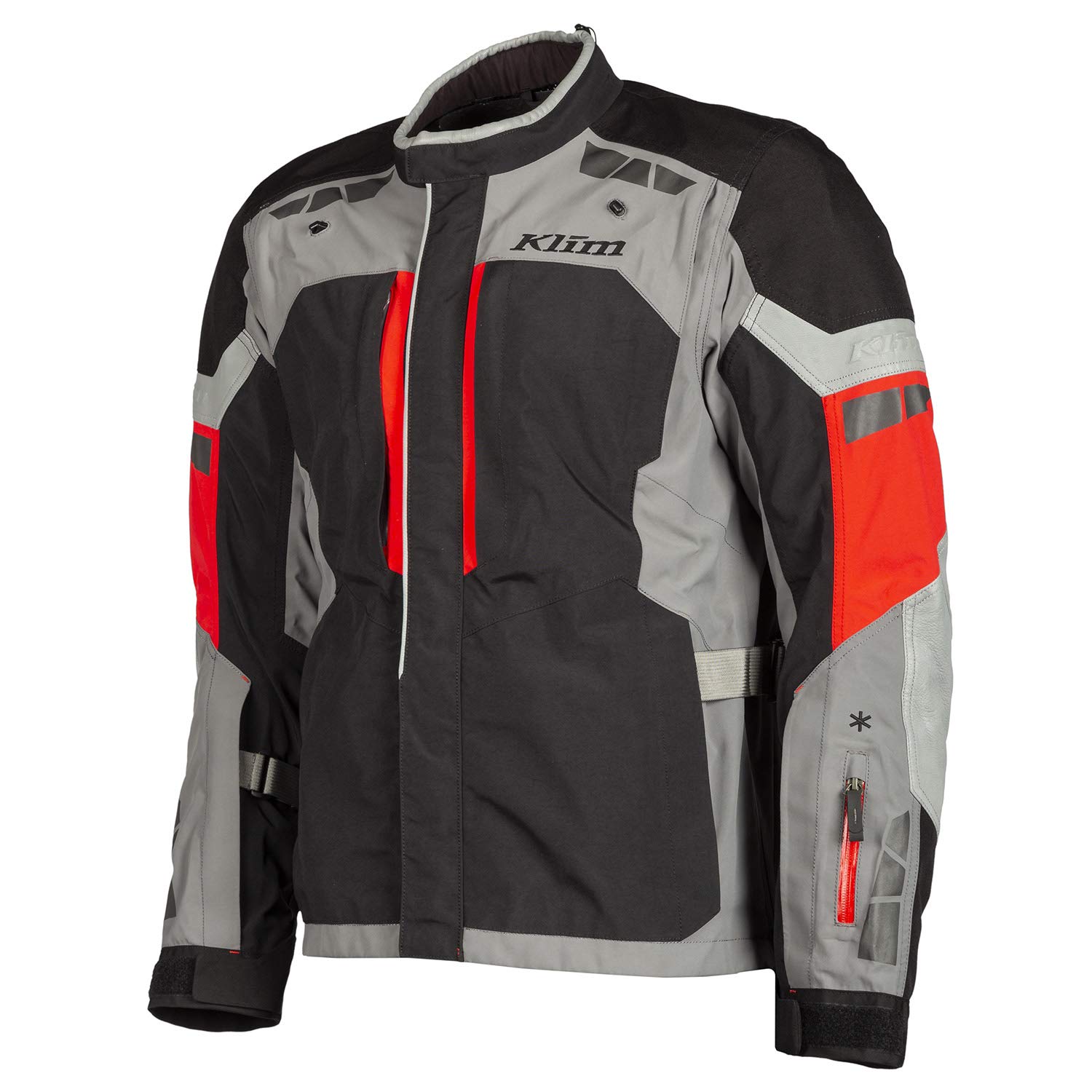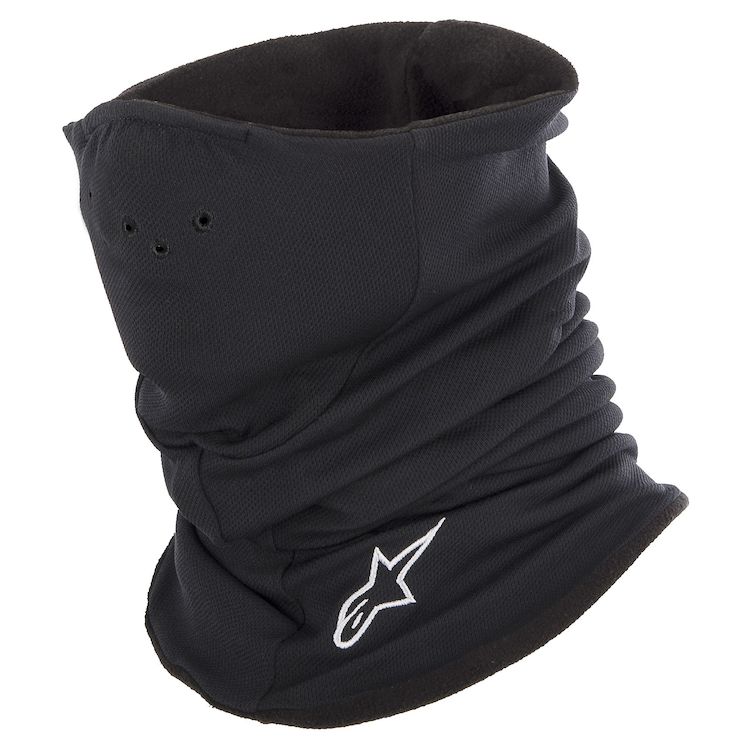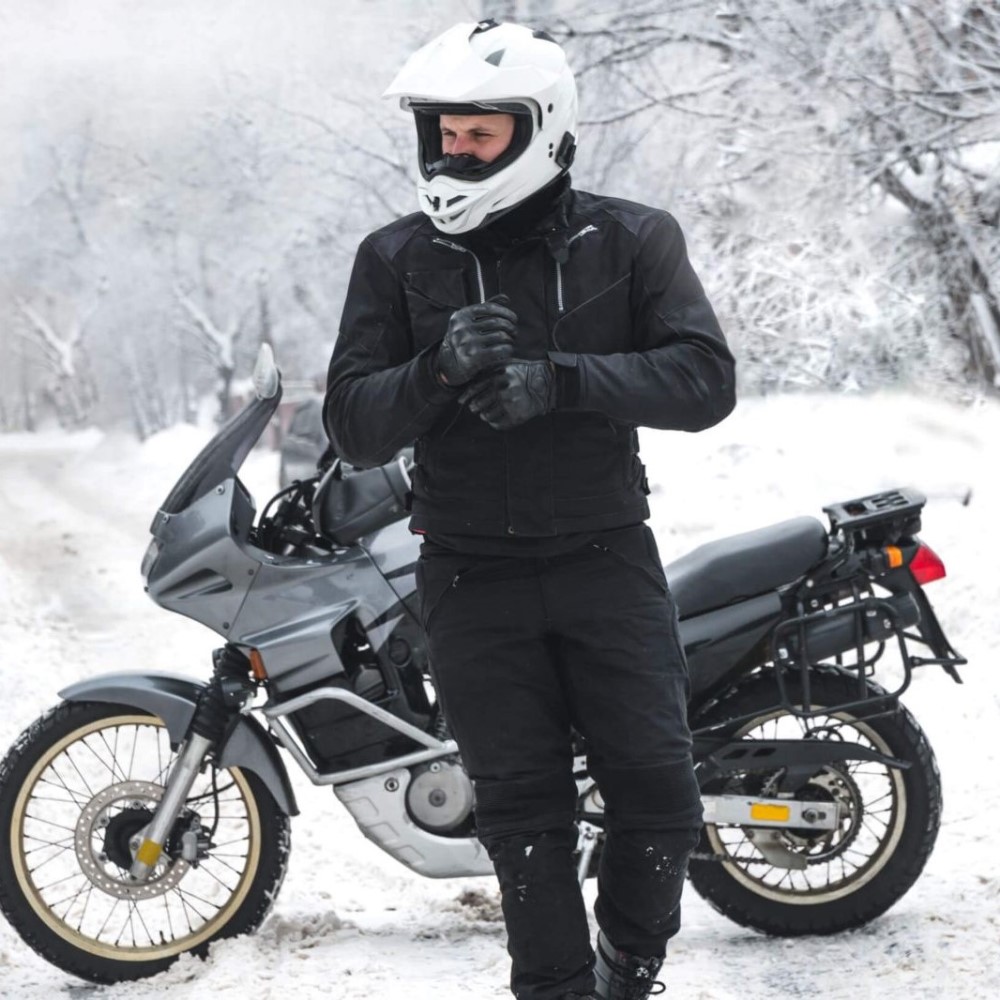The Importance of Proper Motorcycle Attire in Cold Weather
Riding a motorcycle in cold climates demands specific gear. Proper attire does more than keep you warm; it’s vital for your safety. In low temperatures, your body can lose heat fast. This can impair muscle function and reaction times. Worse, it can lead to hypothermia. Quality cold weather motorcycle clothes shield you from wind chill, which can be severe at high speeds. They keep your core temperature stable. This way, your focus remains on the road, not on the cold. Durable fabrics also protect against road rash in case of a slide out. High-tech materials help here. They often offer both insulation and abrasion resistance.
Investing in the right gear also means comfort. With comfort, you can enjoy longer rides without the distraction of the cold biting at you. It’s important not to underestimate the power of being well-equipped for chilly rides. Ensuring you are properly dressed also shows a commitment to responsible riding. Always remember, the right gear could make all the difference if conditions turn harsh.

Essential Motorcycle Clothing for Cold Climates
Choosing the right cold weather motorcycle clothes is a multi-layered approach. This clothing must protect against the cold, wind, and potential accidents. When temperatures drop, you need more than just a standard motorcycle jacket and pants.
Layering Strategies for Motorcyclists
Layering is key to warmth and flexibility in cold weather. Start with a moisture-wicking base layer. It keeps your skin dry. Add an insulating middle layer, like fleece or wool. It traps heat. Top it off with a windproof and waterproof outer layer. This protects against weather elements. Zippers or vents provide ventilation, preventing overheating.
Materials and Fabrics Best Suited for Cold Weather Riding
Look for materials that offer warmth and protection. Synthetics like polyester and nylon are common. They are light and dry quickly. Natural materials like wool provide excellent insulation. For the outer shell, choose fabrics with a water-resistant coating. Leather is great for abrasion resistance. Remember to balance warmth, protection, and mobility when selecting your gear.
Key Features to Look for in Cold Weather Motorcycle Gear
When hunting for cold weather motorcycle clothes, prioritize features that ensure safety and comfort. The ideal gear will have several key characteristics.
Insulation
Insulation is crucial. Look for gear with built-in layers that trap body heat. Thermal linings can add extra warmth, too.
Windproof
A windproof design is a must. It blocks the biting chill at high speeds. This keeps your core temperature stable.
Waterproof
Seek waterproof materials. They prevent moisture from seeping in. This keeps you dry in rain or snow.
Breathability
Choose breathable fabrics. These let sweat escape without letting cold air in. It helps regulate your body temperature.
Durability
Durable materials last longer. They stand up to abrasion and protect in case of a slide.
Reflective Elements
Reflective detailing makes you visible. It adds safety for night or foggy conditions.
Fit and Comfort
Ensure a snug fit that allows full range of motion. Comfortable gear lets you focus on the road, not the fit.
Compatibility with Other Gear
Your cold weather attire should work together. Helmets, gloves, and boots must integrate well with jackets and pants.
Selecting cold weather motorcycle gear with these features will enhance your riding experience and safety. Keep these factors in mind on your next purchase.
Cold Weather Motorcycle Jackets: Types and Recommendations
When the temperature drops, a high-quality cold weather motorcycle jacket becomes a rider’s first line of defense. It must be both functional and comfortable while providing protection from the elements. Here are types and recommendations to consider for your next ride in the chill:
Types of Cold Weather Motorcycle Jackets
There are several types to choose from, each with its own benefits:
Leather Jackets: They offer excellent abrasion resistance and can shield against wind. Opt for ones with added thermal liners for insulation.
Textile Jackets: These are usually lighter and have waterproof and windproof properties. Look for features like detachable liners for adjustable warmth.
Hybrid Jackets: Combining leather and textile materials, hybrid jackets provide a balance of durability and comfort while often being more versatile.
Recommendations for Jacket Features
When selecting a jacket, prioritize these features for the best experience:
Insulation: Ensure the jacket comes with sufficient insulation for heat retention.
Weatherproofing: Choose jackets with windproof and waterproof layers to keep harsh elements at bay.
Breathability: Jackets with ventilation systems help maintain body temperature and prevent sweating.
Visibility: A jacket with reflective strips can enhance safety in low-light conditions.
Pockets: Adequate pocket space is useful for carrying essentials on a long ride.
Adjustable Fit: Features like adjustable cuffs and waist straps help tailor the jacket to your body, improving comfort and insulation.
Invest in a quality jacket that encompasses these features, as it could drastically enhance your cold weather riding experience. Always try on jackets to find the best fit, and remember to match them with the rest of your cold weather motorcycle clothes for a comprehensive gear setup.
 Motorcycle Pants and Leg Protection for Lower Body Warmth
Motorcycle Pants and Leg Protection for Lower Body Warmth
Choosing the right motorcycle pants is crucial for lower body warmth in cold climates. In cold weather, proper leg protection makes a significant difference in comfort and safety. Motorcycle pants designed for cold temperatures offer multiple layers. These layers work to trap body heat and provide a barrier against the cold. Look for pants with a durable outer shell. This shell should resist wind and water. Insulated liners are key for warmth. Some pants come with removable liners for temperature adjustments.
Ensure that your pants have abrasion-resistant material such as leather or reinforced textiles. This offers protection in case of a slide. For added safety, seek pants with built-in or attachable armor. This armor typically covers the knees and hips. Pants with reflective material increase visibility to others, enhancing safety.
For an ideal fit, choose pants that allow ease of movement. They should be snug but not restrict your riding posture. Motorcycle pants often have adjustable waistbands and stretch panels for a better fit. Zippers at the ankles may ease putting on and taking off boots.
When selecting motorcycle pants for cold weather, it’s important to consider integration with your jacket. Many pants have connecting zippers to pair with jackets. This creates a unified barrier against the cold. Additionally, look for pants with pockets. Pockets help you carry personal items securely during your ride. Keep these considerations in mind when shopping for cold weather motorcycle clothes.
Gloves and Hand Protection for Riding in Cold Temperatures
In cold weather, hands are often the first to suffer from the chill. It’s vital to shield them with the right gloves for warmth and control. Here’s what to look for in cold weather motorcycle gloves:
- Insulation is key. Thicker gloves with thermal linings offer necessary warmth.
- Waterproof gloves keep hands dry, a must in snowy or rainy conditions.
- Windproof materials cut down on the cooling effect of the wind.
- Dexterity in gloves allows for easy manipulation of controls.
- Touchscreen compatibility can be helpful for using devices without removing gloves.
- Grip is important. Look for textured palms that help hold onto the handlebars securely.
- Adjustable Wrist Closures provide a snug fit and prevent cold air from entering.
When choosing gloves, balance warmth with the ability to handle your bike safely. Always try them on with your jacket to make sure they integrate well. Remember, quality gloves can make a big difference in your cold weather motorcycle rides. They protect not just from the cold, but also from road rash in case of a spill.
Footwear: Choosing the Right Boots for Winter Rides
When riding in cold weather, the right boots are essential. They keep your feet warm, dry, and protected. Look for these features in winter motorcycle boots:
- Insulation: Boots with insulation retain heat to keep your feet warm.
- Waterproofing: Durable, water-resistant boots shield your feet from rain or snow.
- Durability: Strong materials like leather can withstand rough conditions.
- Ankle Protection: Good boots offer support and protection for your ankles.
- Non-Slip Soles: Soles with traction prevent slipping on wet or icy surfaces.
- Easy Entry and Exit: Zippers or Velcro make it easier to put on and take off boots.
- Compatibility with Pants: Ensure boots fit well with your motorcycle pants for full protection.
It’s important to try on different boots. Make sure they’re comfortable for long rides. They should also work well with your motorcycle’s foot controls. Quality winter boots are a must-have part of your cold weather motorcycle clothes.
Helmets and Head Gear for Cold Weather Protection
In icy conditions, a helmet is more than a safety requirement; it’s a warmth shield. The right helmet for cold weather has features to protect against freezing temperatures. Look for helmets with insulation and a snug fit that covers your head and neck. A full-face design is best as it offers max coverage. Many come with fog-resistant face shields, crucial for clear vision. Consider a helmet with internal lining made of materials like fleece for added warmth.
Helmets should also have proper ventilation systems. These systems stop the visor from fogging up without letting cold air in. Adjustable vents allow you to control airflow based on the outside temperature. Detachable breath guards can help by directing your breath away from the shield.
Combined with a well-fitting helmet, bikers should use balaclavas or neck gaiters. These add an extra layer of warmth and can be tucked into your jacket, blocking any drafts. Remember, gear that’s too tight can restrict blood flow, making you colder. So, choose headgear that fits snugly, yet comfortably.
Ensure your helmet is compatible with your cold weather motorcycle clothes. It must work with your jacket collar and not restrict your head movements. For added safety, look for helmets with reflective elements. These will help other drivers see you in dark or foggy conditions.
Quality headgear can greatly enhance your cold weather riding experience. It keeps you comfortable, helping you maintain focus on the road. Choose a helmet and headgear that offer the protection you need against the chill.
Additional Accessories for Cold Weather Motorcycle Riding
Beyond the basic cold weather motorcycle clothes, there are accessories that can boost your comfort. These items add extra layers of warmth and protection. Let’s explore some additions that are worth considering for those extra chilly rides.
Heated Gear Options for Extra Warmth
Heated gear is a game-changer in cold climates. Items like heated vests, gloves, and socks use battery power to provide warmth. Look for gear with adjustable heat settings. This allows you to control the temperature. Make sure the batteries are long-lasting. They should sustain a charge for your entire ride. Heated grips can also be installed on your motorcycle. They keep your hands warm without the bulk of heavy gloves.
Protective Covers and Barriers Against the Cold
Face shields and balaclavas guard against cold winds on your face. Neck gaiters offer warmth and prevent drafts from entering your jacket. For your bike, consider windshields and handguards. They block cold air as you ride. A cover for your motorcycle seat can also retain heat. This stops the cold from seeping through your clothing. These barriers can make a big impact. They help you stay warm from head to toe.
To ensure you are well-prepared, add these accessories to your list of cold weather motorcycle clothes. They can make your winter rides much more enjoyable.
 Maintenance and Care Tips for Cold Weather Motorcycle Apparel
Maintenance and Care Tips for Cold Weather Motorcycle Apparel
The longevity and performance of cold weather motorcycle clothes hinge on proper maintenance and care. Here’s how to keep your gear in top condition:
- Clean Regularly: Dirt and road grime can break down fabric fibers. Wash your gear as the manufacturer recommends. Avoid harsh chemicals.
- Condition Leather: If you have leather gear, use a leather conditioner. This keeps it supple and water-resistant.
- Dry Gear Thoroughly: Never pack away damp gear. Mold and mildew can form. Air dry your gear after washing or riding in rain.
- Check for Wear and Tear: Regularly inspect for signs of damage. Repair any tears or broken zippers promptly.
- Store Properly: Keep your motorcycle clothes in a dry, cool place. Avoid folding leather, which can cause creases. Use hangers for jackets and pants.
- Waterproof Treatment: Reapply waterproof coatings as needed. Durable water repellent (DWR) sprays can renew your gear’s water resistance.
- Lubricate Zippers: Use a silicone lubricant on zippers. This ensures they move smoothly and don’t stick.
- Avoid Direct Heat: When drying gear, avoid direct heat sources. They can damage materials and reduce the gear’s effectiveness.
Following these care tips will ensure that your cold weather motorcycle clothes are always ready for the road. Proper care not only extends the life of your gear but also maintains its protective properties for safe and warm rides.
